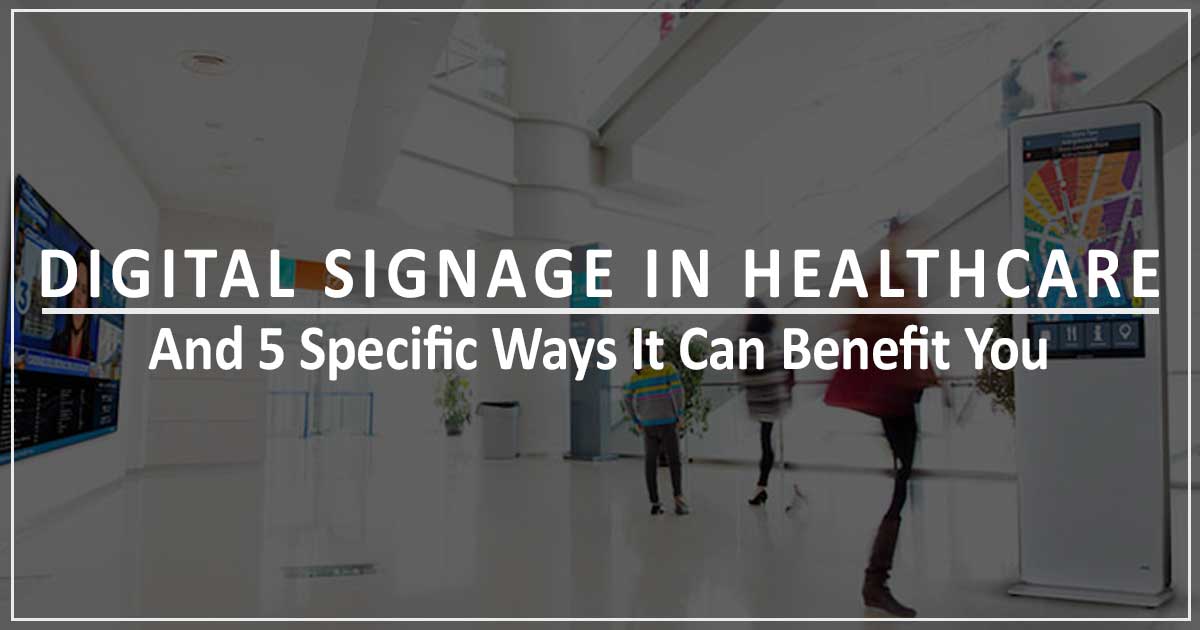
5 Ways to Use Digital Displays in Hospitals
It’s easy to get lost in a hospital. Important information gets lost in the shuffle. Patient education can get lost in translation. Visitors — and sometimes even staff — can get lost in the hallways.
Hospitals are big, busy places. Clear communication leads to a better patient experience, more desirable health outcomes and better visibility for the hospital’s brand. And in the digital age, what better way to communicate important, real-time information than on a screen — a really big screen?
By improving communication, wayfinding signage and other digital displays also improve the patient experience. Here are some benefits and applications of using digital signage in hospitals:
WAYFINDING
Healthcare providers know patients and visitors struggle to navigate the maze-like designs of modern medical complexes — if only because they’re repeatedly stopped and asked, “Can you help me? I’m lost.”
Wayfinding interruptions cost hospitals approximately $220,000 per year, not including negative effects on the patient experience. Digital wayfinding signage with touch-screen capabilities enables visitors to get customized directions to exactly where they need to go. It also frees up hospital staff from directing traffic.
Some of the latest wayfinding signage even communicates with smartphones. For example, Emory University Hospital in Atlanta uses a Hypersign/Samsung solution that enables visitors to download wayfinding tools from digital signage onto their smartphones and get step-by-step directions.
Patient Room Engagement
Patient education and engagement have always been priorities for hospitals. The better patients understand their conditions and the greater responsibility they take for getting well, the better health outcomes care teams can deliver. But in recent years, hospitals have begun to place a greater emphasis on patient-centered care and shared decision-making, thus improving the patient experience and reducing readmissions through better patient education.
Bedside digital signage replaces the traditional whiteboard — which requires constant updating once the patient is admitted — with personalized, up-to-date information, such as room phone number, names and photos of the care team and most recent vital signs.
Combining those eBoards with TVs and tablets makes them interactive, enabling patients to watch educational videos about their conditions and surgeries or procedures they’re scheduled to have. By integrating the hospital’s electronic health records system, many eBoard solutions also provide patients access to their test results, treatment plans, daily schedules and other medical data.
Reduced Waiting Room Anxiety
No one likes to wait. It’s even worse when you’re feeling ill or waiting for a loved one to come out of surgery. Digital waiting room signage alleviates some of that anxiety by announcing the average wait time or providing engaging health content to distract patients.
In surgical waiting rooms, digital signage can share status updates with family, using assigned numbers rather than names to protect patient privacy. Family members can see exactly when patients go into the operating room, how long they’re in there and when they’re moved to recovery. This alleviates anxiety for family and takes the burden off staff to keep everyone informed.
Signage within waiting rooms can also connect visitors to the outside world through displaying information about local restaurants, news, traffic and weather.
Real-Time Visitor Communication
Hospitals have important information to communicate to patients and visitors. Along with promoting hospital services and events, there are public safety announcements, patient safety recommendations, workplace safety tips, wellness awareness content and much more.
The old way — paper fliers stapled to cluttered bulletin boards or taped to walls — is messy and ineffective. Information becomes outdated, and the most important announcements often go unnoticed in the sea of fliers.
With digital signage, hospitals can be more strategic about what information to share, when and where. Information stays updated, and system administrators can push real-time alerts in emergency situations.
Digital signage also modernizes hospital cafeterias. Rather than writing daily menus on chalkboards or printing more fliers, staff can quickly change out the daily specials, remove sold-out items, alter pricing and make other adjustments on the fly.
Greater Revenue
Improving the patient experience and reducing readmissions already helps to increase revenue. Satisfied patients are more likely to use the hospital again and to refer others, and hospitals with low patient satisfaction scores and high readmission rates face government penalties.
There are other monetary benefits of digital signage in hospitals. Displays can promote hospital services or affiliate clinics, lure visitors to the cafeteria with today’s lunch special or advertise sales in the gift shop. Hospitals can build brand visibility by announcing recent awards the team has won or profiling top doctors on staff. Some hospitals could also rent advertising space on digital displays. Finally, digital signs are a great place to recognize hospital donors and solicit more donations.
These are just some potential use cases and benefits of digital signage in hospitals. As more hospitals invest in digital signage, the possibilities will only be limited by the creativity of technology vendors and healthcare IT teams.
Call us at our office in Downtown pensacola at 850.432-8080 or send us a message via our contact form!
0 Comments
Comments are closed.

